Kaishen Yuan
AU-LLM: Micro-Expression Action Unit Detection via Enhanced LLM-Based Feature Fusion
Jul 29, 2025Abstract:The detection of micro-expression Action Units (AUs) is a formidable challenge in affective computing, pivotal for decoding subtle, involuntary human emotions. While Large Language Models (LLMs) demonstrate profound reasoning abilities, their application to the fine-grained, low-intensity domain of micro-expression AU detection remains unexplored. This paper pioneers this direction by introducing \textbf{AU-LLM}, a novel framework that for the first time uses LLM to detect AUs in micro-expression datasets with subtle intensities and the scarcity of data. We specifically address the critical vision-language semantic gap, the \textbf{Enhanced Fusion Projector (EFP)}. The EFP employs a Multi-Layer Perceptron (MLP) to intelligently fuse mid-level (local texture) and high-level (global semantics) visual features from a specialized 3D-CNN backbone into a single, information-dense token. This compact representation effectively empowers the LLM to perform nuanced reasoning over subtle facial muscle movements.Through extensive evaluations on the benchmark CASME II and SAMM datasets, including stringent Leave-One-Subject-Out (LOSO) and cross-domain protocols, AU-LLM establishes a new state-of-the-art, validating the significant potential and robustness of LLM-based reasoning for micro-expression analysis. The codes are available at https://github.com/ZS-liu-JLU/AU-LLMs.
Period-LLM: Extending the Periodic Capability of Multimodal Large Language Model
May 30, 2025Abstract:Periodic or quasi-periodic phenomena reveal intrinsic characteristics in various natural processes, such as weather patterns, movement behaviors, traffic flows, and biological signals. Given that these phenomena span multiple modalities, the capabilities of Multimodal Large Language Models (MLLMs) offer promising potential to effectively capture and understand their complex nature. However, current MLLMs struggle with periodic tasks due to limitations in: 1) lack of temporal modelling and 2) conflict between short and long periods. This paper introduces Period-LLM, a multimodal large language model designed to enhance the performance of periodic tasks across various modalities, and constructs a benchmark of various difficulty for evaluating the cross-modal periodic capabilities of large models. Specially, We adopt an "Easy to Hard Generalization" paradigm, starting with relatively simple text-based tasks and progressing to more complex visual and multimodal tasks, ensuring that the model gradually builds robust periodic reasoning capabilities. Additionally, we propose a "Resisting Logical Oblivion" optimization strategy to maintain periodic reasoning abilities during semantic alignment. Extensive experiments demonstrate the superiority of the proposed Period-LLM over existing MLLMs in periodic tasks. The code is available at https://github.com/keke-nice/Period-LLM.
FEALLM: Advancing Facial Emotion Analysis in Multimodal Large Language Models with Emotional Synergy and Reasoning
May 19, 2025Abstract:Facial Emotion Analysis (FEA) plays a crucial role in visual affective computing, aiming to infer a person's emotional state based on facial data. Scientifically, facial expressions (FEs) result from the coordinated movement of facial muscles, which can be decomposed into specific action units (AUs) that provide detailed emotional insights. However, traditional methods often struggle with limited interpretability, constrained generalization and reasoning abilities. Recently, Multimodal Large Language Models (MLLMs) have shown exceptional performance in various visual tasks, while they still face significant challenges in FEA due to the lack of specialized datasets and their inability to capture the intricate relationships between FEs and AUs. To address these issues, we introduce a novel FEA Instruction Dataset that provides accurate and aligned FE and AU descriptions and establishes causal reasoning relationships between them, followed by constructing a new benchmark, FEABench. Moreover, we propose FEALLM, a novel MLLM architecture designed to capture more detailed facial information, enhancing its capability in FEA tasks. Our model demonstrates strong performance on FEABench and impressive generalization capability through zero-shot evaluation on various datasets, including RAF-DB, AffectNet, BP4D, and DISFA, showcasing its robustness and effectiveness in FEA tasks. The dataset and code will be available at https://github.com/953206211/FEALLM.
AU-TTT: Vision Test-Time Training model for Facial Action Unit Detection
Mar 30, 2025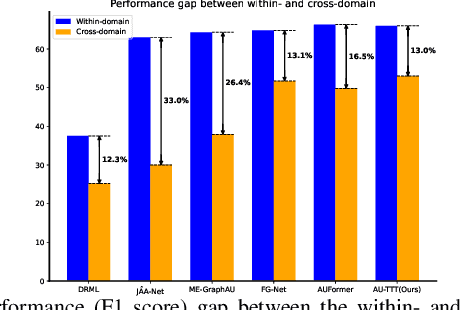
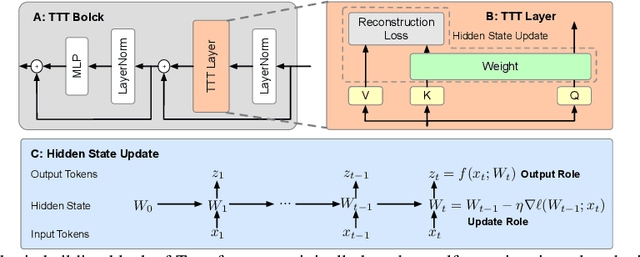
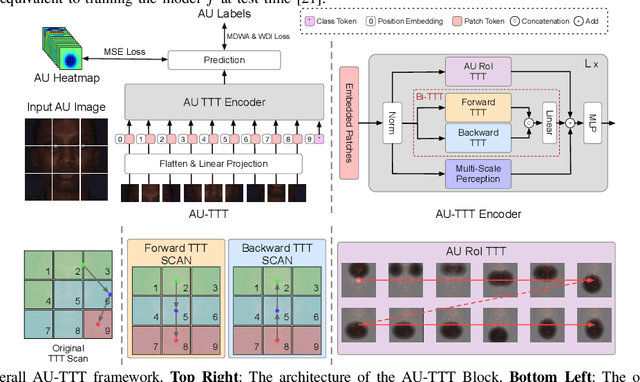
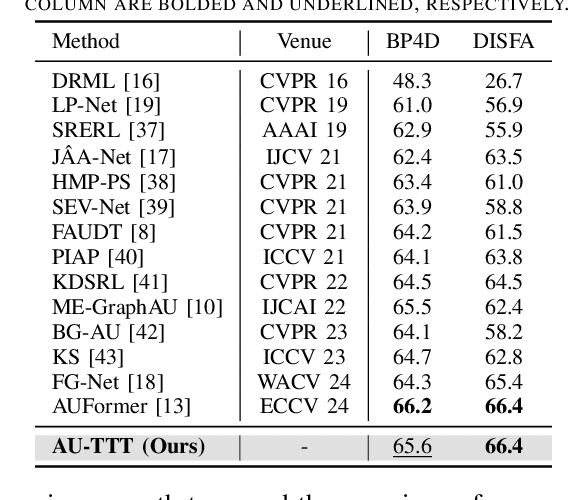
Abstract:Facial Action Units (AUs) detection is a cornerstone of objective facial expression analysis and a critical focus in affective computing. Despite its importance, AU detection faces significant challenges, such as the high cost of AU annotation and the limited availability of datasets. These constraints often lead to overfitting in existing methods, resulting in substantial performance degradation when applied across diverse datasets. Addressing these issues is essential for improving the reliability and generalizability of AU detection methods. Moreover, many current approaches leverage Transformers for their effectiveness in long-context modeling, but they are hindered by the quadratic complexity of self-attention. Recently, Test-Time Training (TTT) layers have emerged as a promising solution for long-sequence modeling. Additionally, TTT applies self-supervised learning for iterative updates during both training and inference, offering a potential pathway to mitigate the generalization challenges inherent in AU detection tasks. In this paper, we propose a novel vision backbone tailored for AU detection, incorporating bidirectional TTT blocks, named AU-TTT. Our approach introduces TTT Linear to the AU detection task and optimizes image scanning mechanisms for enhanced performance. Additionally, we design an AU-specific Region of Interest (RoI) scanning mechanism to capture fine-grained facial features critical for AU detection. Experimental results demonstrate that our method achieves competitive performance in both within-domain and cross-domain scenarios.
EMO-LLaMA: Enhancing Facial Emotion Understanding with Instruction Tuning
Aug 21, 2024



Abstract:Facial expression recognition (FER) is an important research topic in emotional artificial intelligence. In recent decades, researchers have made remarkable progress. However, current FER paradigms face challenges in generalization, lack semantic information aligned with natural language, and struggle to process both images and videos within a unified framework, making their application in multimodal emotion understanding and human-computer interaction difficult. Multimodal Large Language Models (MLLMs) have recently achieved success, offering advantages in addressing these issues and potentially overcoming the limitations of current FER paradigms. However, directly applying pre-trained MLLMs to FER still faces several challenges. Our zero-shot evaluations of existing open-source MLLMs on FER indicate a significant performance gap compared to GPT-4V and current supervised state-of-the-art (SOTA) methods. In this paper, we aim to enhance MLLMs' capabilities in understanding facial expressions. We first generate instruction data for five FER datasets with Gemini. We then propose a novel MLLM, named EMO-LLaMA, which incorporates facial priors from a pretrained facial analysis network to enhance human facial information. Specifically, we design a Face Info Mining module to extract both global and local facial information. Additionally, we utilize a handcrafted prompt to introduce age-gender-race attributes, considering the emotional differences across different human groups. Extensive experiments show that EMO-LLaMA achieves SOTA-comparable or competitive results across both static and dynamic FER datasets. The instruction dataset and code are available at https://github.com/xxtars/EMO-LLaMA.
GPT as Psychologist? Preliminary Evaluations for GPT-4V on Visual Affective Computing
Mar 09, 2024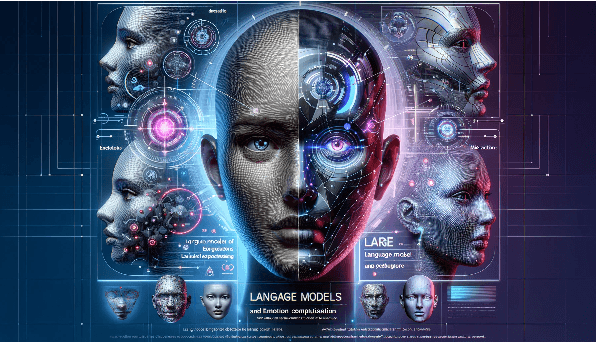

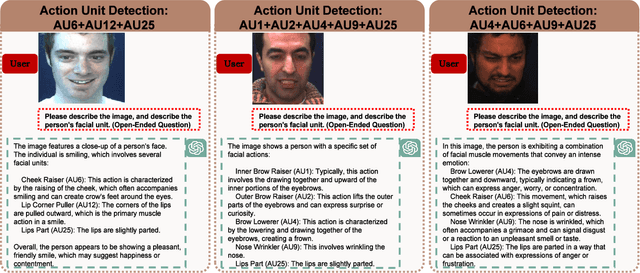
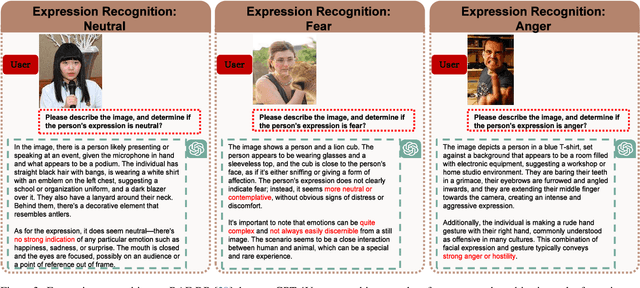
Abstract:Multimodal language models (MLMs) are designed to process and integrate information from multiple sources, such as text, speech, images, and videos. Despite its success in language understanding, it is critical to evaluate the performance of downstream tasks for better human-centric applications. This paper assesses the application of MLMs with 5 crucial abilities for affective computing, spanning from visual affective tasks and reasoning tasks. The results show that GPT4 has high accuracy in facial action unit recognition and micro-expression detection while its general facial expression recognition performance is not accurate. We also highlight the challenges of achieving fine-grained micro-expression recognition and the potential for further study and demonstrate the versatility and potential of GPT4 for handling advanced tasks in emotion recognition and related fields by integrating with task-related agents for more complex tasks, such as heart rate estimation through signal processing. In conclusion, this paper provides valuable insights into the potential applications and challenges of MLMs in human-centric computing. The interesting samples are available at \url{https://github.com/LuPaoPao/GPT4Affectivity}.
AUFormer: Vision Transformers are Parameter-Efficient Facial Action Unit Detectors
Mar 07, 2024Abstract:Facial Action Units (AU) is a vital concept in the realm of affective computing, and AU detection has always been a hot research topic. Existing methods suffer from overfitting issues due to the utilization of a large number of learnable parameters on scarce AU-annotated datasets or heavy reliance on substantial additional relevant data. Parameter-Efficient Transfer Learning (PETL) provides a promising paradigm to address these challenges, whereas its existing methods lack design for AU characteristics. Therefore, we innovatively investigate PETL paradigm to AU detection, introducing AUFormer and proposing a novel Mixture-of-Knowledge Expert (MoKE) collaboration mechanism. An individual MoKE specific to a certain AU with minimal learnable parameters first integrates personalized multi-scale and correlation knowledge. Then the MoKE collaborates with other MoKEs in the expert group to obtain aggregated information and inject it into the frozen Vision Transformer (ViT) to achieve parameter-efficient AU detection. Additionally, we design a Margin-truncated Difficulty-aware Weighted Asymmetric Loss (MDWA-Loss), which can encourage the model to focus more on activated AUs, differentiate the difficulty of unactivated AUs, and discard potential mislabeled samples. Extensive experiments from various perspectives, including within-domain, cross-domain, data efficiency, and micro-expression domain, demonstrate AUFormer's state-of-the-art performance and robust generalization abilities without relying on additional relevant data. The code for AUFormer is available at https://github.com/yuankaishen2001/AUFormer.
Multi-scale Promoted Self-adjusting Correlation Learning for Facial Action Unit Detection
Aug 15, 2023Abstract:Facial Action Unit (AU) detection is a crucial task in affective computing and social robotics as it helps to identify emotions expressed through facial expressions. Anatomically, there are innumerable correlations between AUs, which contain rich information and are vital for AU detection. Previous methods used fixed AU correlations based on expert experience or statistical rules on specific benchmarks, but it is challenging to comprehensively reflect complex correlations between AUs via hand-crafted settings. There are alternative methods that employ a fully connected graph to learn these dependencies exhaustively. However, these approaches can result in a computational explosion and high dependency with a large dataset. To address these challenges, this paper proposes a novel self-adjusting AU-correlation learning (SACL) method with less computation for AU detection. This method adaptively learns and updates AU correlation graphs by efficiently leveraging the characteristics of different levels of AU motion and emotion representation information extracted in different stages of the network. Moreover, this paper explores the role of multi-scale learning in correlation information extraction, and design a simple yet effective multi-scale feature learning (MSFL) method to promote better performance in AU detection. By integrating AU correlation information with multi-scale features, the proposed method obtains a more robust feature representation for the final AU detection. Extensive experiments show that the proposed method outperforms the state-of-the-art methods on widely used AU detection benchmark datasets, with only 28.7\% and 12.0\% of the parameters and FLOPs of the best method, respectively. The code for this method is available at \url{https://github.com/linuxsino/Self-adjusting-AU}.
 Add to Chrome
Add to Chrome Add to Firefox
Add to Firefox Add to Edge
Add to Edge